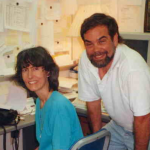The theoretical and practical foundations for Modeling Instruction were thoroughly developed, tested and published during this period of physics education research. In these early years, there were three distinct (but strongly coupled) lines of research:
(1) Research on the role of student prior knowledge on learning physics, which led to development of the Force Concept Inventory and Mechanics Baseline Test as primary instruments for evaluating student mastery of introductory physics. The Force Concept Inventory (FCI) has since become the most widely used instrument for evaluating effectiveness of physics instruction.
(2) The theoretical framework for modeling pedagogy and curriculum design was laid out by Hestenes, and successfully tested in university physics. Research on refinement and implementation of modeling pedagogy has continued to this day.
(3) Modeling pedagogy was brilliantly adapted to high school physics by Malcolm Wells. The test of this innovation in Wells’ doctoral thesis is surely one of the most well-controlled and significant physics education experiments of all time. His primary treatment and control groups differed only in the pedagogy used, and the effect was large!
Wells’ doctoral supervisor (Hestenes) was so impressed with the result that he put aside his physics research to join Wells on a proof-of-concept NSF grant to see if training in modeling pedagogy could improve the performance of other teachers. It is noteworthy that, from the beginning, the FCI played an essential role in quality control and design of effective workshops. After the first summer workshop, the teachers eagerly tried out what they had learned, but were surprised that the FCI showed no gain in student learning. This led to the realization that the teachers had concentrated so much on the instructional materials and student activities that they overlooked essential elements of the modeling pedagogy. That was corrected in the next summer workshop, and the results were sufficient to justify an NSF grant to bring Modeling Instruction to more teachers.
For more details see the History of Modeling page on the legacy site at Arizona State University.


